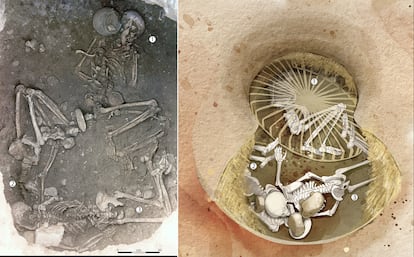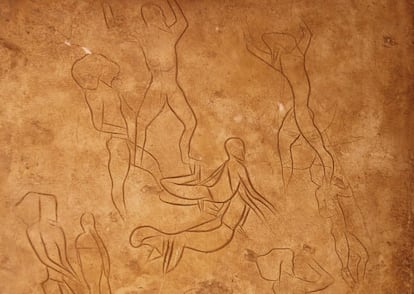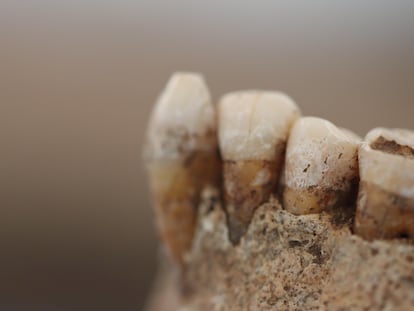First European farmers practiced ritual killing used today by the mafia
The first examples of ‘incaprettamento’ appear in cave paintings in southern Italy dated to the European Mesolithic period

They must have still been alive when the two women were placed in the silo, imprisoned between grinding stones. They were placed face down, with their legs bent backwards, a slip-knotted rope running from their necks to their ankles. They suffocated themselves: as they tired, they would have extended their legs and were thus strangled. This is the conclusion reached by a group of scientists, including forensic experts from the Institute of Legal Medicine in Paris, after studying a burial site in the Rhône Valley in southeastern France dated to between 6,000 and 5,500 years ago, during the European Neolithic period. By reviewing other sites of the same period, they have found that this practice was common among the first European agricultural communities, finding similar sacrifices both in the east of the continent and in northern Spain. This form torture is known by an Italian word, incaprettamento. It is one of the Mafia’s most brutal methods of killing even today.
The first reference to incaprettamento was found in drawings in the cave of Addaura, near Palermo, in Sicily — paradoxically the birthplace of one of the historically most powerful Italian mafias, Cosa Nostra. Surrounded by other people standing, probably during a ritual dance, two people are observed on the floor, bound from the feet to the neck. The paintings belong to the European Mesolithic period, without an exact dating, but made millennia before and thousands of kilometers away from the asphyxiation of the two women in the Rhône Valley.
At the French site, in Saint-Paul-Trois-Châteaux, the two sacrificed women were inside a kind of silo beside a third woman, who was in a central position and died at about 50 years of age. The three were found in a hollow in the ground. It was not a cemetery and there were no other bodies buried there. But it was not really a silo either: no remains of grain were found, although grinding stones had been broken on purpose, perhaps as part of an offering. Above the burial site there was a wooden structure reminiscent of the dolmens that were erected at the same time in other parts of Europe. The enclosure’s two open ends were sited with a very specific orientation, one coinciding with the beginning of the summer solstice and the other with the setting of the sun during the winter solstice.

For Eric Crubézy, from the University Toulouse III-Paul Sabatier (France) and senior author of the research, everything points to the fact that they were ritually sacrificed. “They are in a silo, in a monument facing the sunrise at the solstice, and there are broken fragments of grinding stones; all this suggests sacrifices related to agriculture, the desire for good harvests, or their preservation.” What Crubézy does not yet know is why the three women were laid out as they were, or whether there was connection between them. The team are now carrying out isotopic and genetic studies to answer those questions.
Intrigued by these cases of incaprettamento, the researchers reviewed the literature on other European Neolithic sites, the period to which the Saint-Paul-Trois-Châteaux burial corresponds. And they found a few more. At 14 sites throughout Europe, they counted up to 20 cases of death by this form of ritual asphyxiation. Although there are women and children, most of those sacrificed were adult men. The oldest instances, dated to around 7,400 years ago, occurred in the Danube Valley and southern present-day Germany. The most recent, in addition to the French case, were found on the Catalan coast of Spain, such as the Bòbila Madurell site in Sant Quirze del Vallès (Barcelona). One of the details that most intrigued the researchers is that the sacrifices were made in different cultures and there is 2,000 years of chronological distance between the oldest and most recent ones.
However, they all have two things in common: they are related to riverine or coastal settlements and occurred within Neolithic farming communities. The authors of the paper, published in Science Advances, say these sites functioned as meeting places where food security and the agricultural cycle were venerated, particularly through the practice of human sacrifice. This could explain the practice being carried out for over 2,000 years and its widespread geographical distribution.
Collège de France professor and archaeologist Jean Guilaine, also a co-author of the study, has a possible explanation that connects these ritual asphyxiations with those depicted in the Addaura cave some 6,000 years earlier: “This shows that these sacrifices endured in Europe for millennia, passing from hunter-gatherers to farmers, because the connection between the depiction in the Sicilian cave and farmers is surely not a coincidence.” The cases of these two women are the latest to have been found in the prehistoric record. The researchers are convinced there must have been many more sacrifices whose sites have not been preserved. However, in the centuries following these ritual asphyxiations, Neolithic funerary practices began to change, giving way to megalithic constructions. The incaprettamento did not reappear again until it began to be used by organized crime to signal traitors.
Sign up for our weekly newsletter to get more English-language news coverage from EL PAÍS USA Edition
More information










































